As we find ourselves in December once more, I'd like to present the third annual Hubble Space Telescope imagery Advent Calendar for 2010. Keep checking this page - every day, for the next 25 days, a new photo will be revealed here from the Hubble Space Telescope, some old and some new. This year there is also a temporary RSS feed for the calendar. I continue to feel very fortunate to have been able to share photographs and stories with you all this year, and I wish for a Happy Holiday season to all those who will celebrate, and for Peace on Earth to everyone. - Alan (25 photos total - eventually)[previously: 2008, 2009]
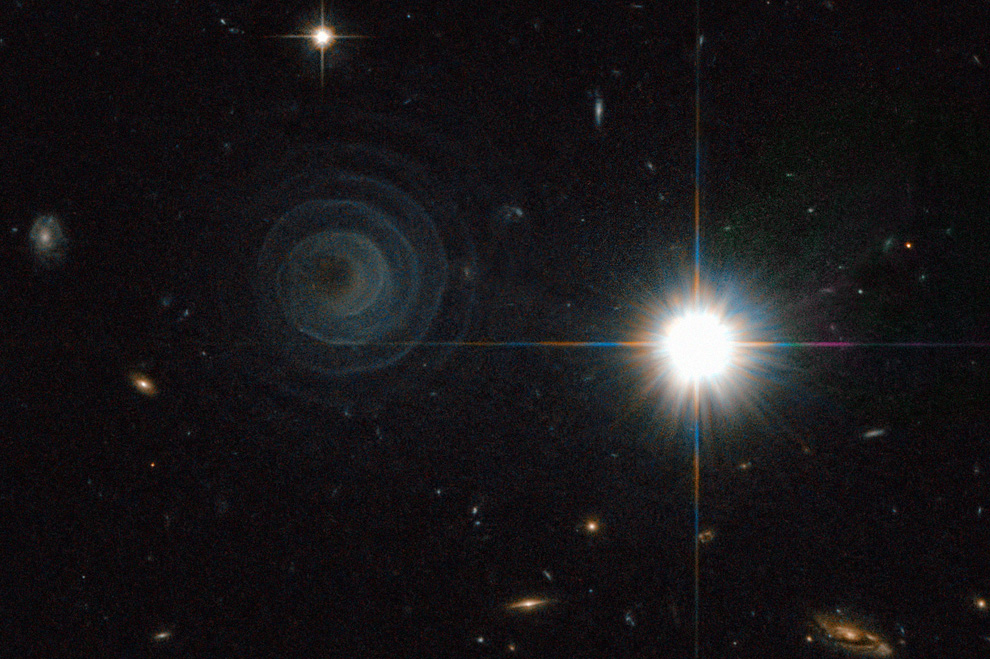
This remarkable picture from the Advanced Camera for Surveys on the NASA/ESA Hubble Space Telescope shows one of the most perfect geometrical forms created in space. It captures the formation of an unusual pre-planetary nebula, known as IRAS 23166+1655, around the star LL Pegasi in the constellation of Pegasus. The image shows what appears to be a thin spiral pattern of astonishingly regularity winding around the star, which is itself hidden behind thick dust. The spiral pattern suggests a regular periodic origin for the nebula's shape. The material forming the spiral is moving outwards a speed of about 50 000 km/hour and, by combining this speed with the distance between layers, astronomers calculate that the shells are each separated by about 800 years. The spiral is thought to arise because LL Pegasi is a binary system, with the star that is losing material and a companion star orbiting each other. (ESA/NASA & R. Sahai) More
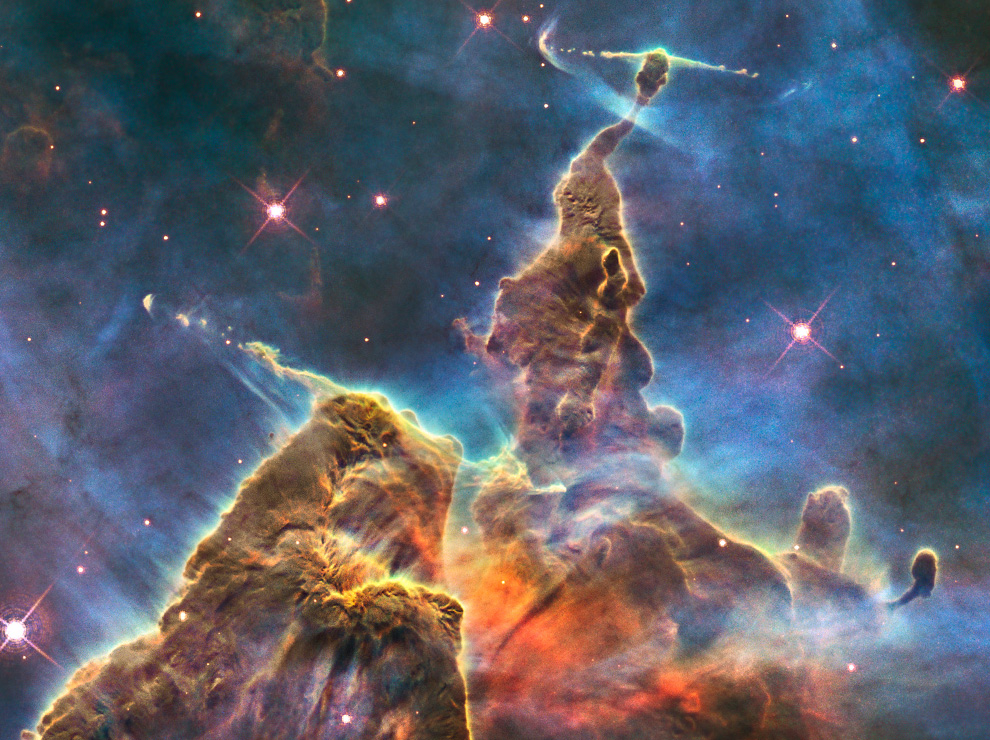
This turbulent cosmic pinnacle lies within a stellar nursery called the Carina Nebula, located 7,500 light-years away in the southern constellation of Carina. Scorching radiation and fast winds (streams of charged particles) from super-hot newborn stars in the nebula are shaping and compressing the pillar, causing new stars to form within it. Streamers of hot ionised gas can be seen flowing off the ridges of the structure, and wispy veils of gas and dust, illuminated by starlight, float around its towering peaks. The denser parts of the pillar are resisting being eroded by radiation. Nestled inside this dense mountain are fledgling stars. Long streamers of gas can be seen shooting in opposite directions from the pedestal at the top of the image. Another pair of jets is visible at another peak near the centre of the image. These jets, (known as HH 901 and HH 902, respectively), are signposts for new star birth and are launched by swirling gas and dust discs around the young stars, which allow material to slowly accrete onto the stellar surfaces. Hubble's Wide Field Camera 3 observed the pillar on 1-2 February 2010. (NASA, ESA, M. Livio and the Hubble 20th Anniversary Team,STScI) More #
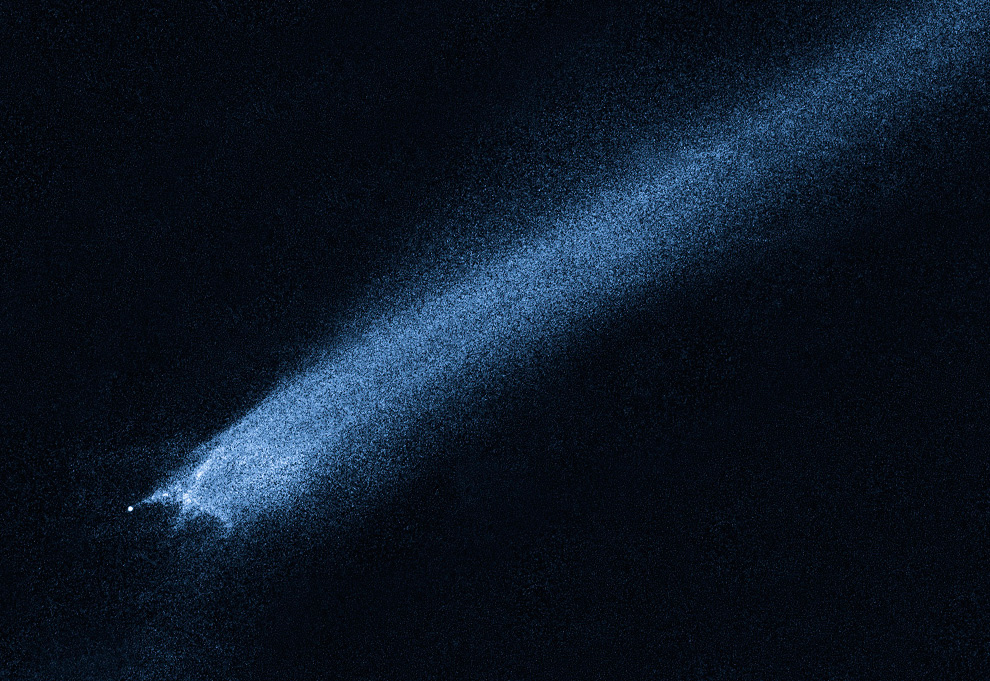
This is a NASA/ESA Hubble Space Telescope picture a comet-like object called P/2010 A2, which was first discovered by the LINEAR (Lincoln Near-Earth Asteroid Research program) sky survey on January 6th, 2010. The object has a complex structure - a pattern of filamentary structures near the point-like nucleus of the object and trailing streamers of dust - that suggests it is not a comet but instead the product of a head-on collision between two asteroids traveling five times faster than a rifle bullet (5 km per second). Astronomers have long thought that the asteroid belt is being ground down through collisions, but such a smashup has never before been seen. The filaments are made of dust and gravel, presumably recently thrown out of the 140-meter-diameter nucleus. Some of the filaments are swept back by radiation pressure from sunlight to create straight dust streaks. At the time of the Hubble observations, the object was approximately 300 million km from the Sun and 140 million km from Earth. (NASA, ESA and D. Jewitt, UCLA) More #
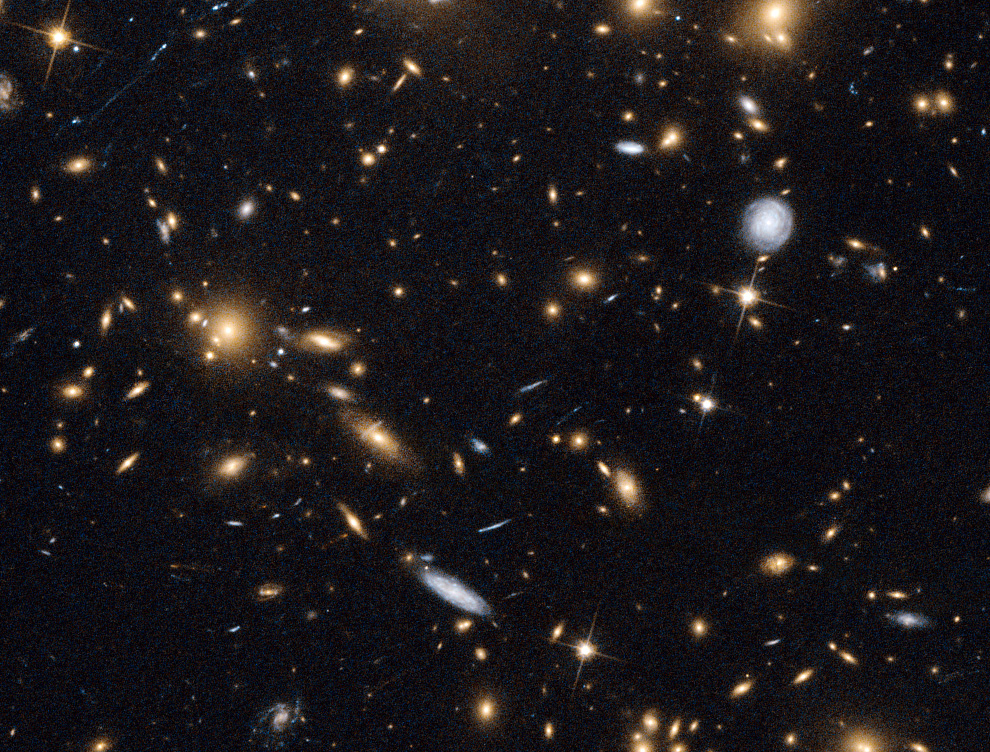
At first glance, the scatter of pale dots on this NASA/ESA Hubble Space Telescope image looks like a snowstorm in the night sky. But almost every one of these delicate snowflakes is a distant galaxy in the cluster MACS J0717.5+3745 and each is home to billions of stars. The amount of mass in this sea of galaxies is huge, and is great enough to visibly bend the fabric of spacetime. The strange distortion in the shapes of many of the galaxies in this picture, which appear stretched and bent as if they were looked at through a glass bottle, is a result of gravitational lensing, where the gravitational fields around massive objects bend light around them. This picture was created from images taken through near-infrared and yellow filters using the Wide Field Channel of Hubble's Advanced Camera for Surveys. (ESA/Hubble, NASA and H. Ebeling) More #
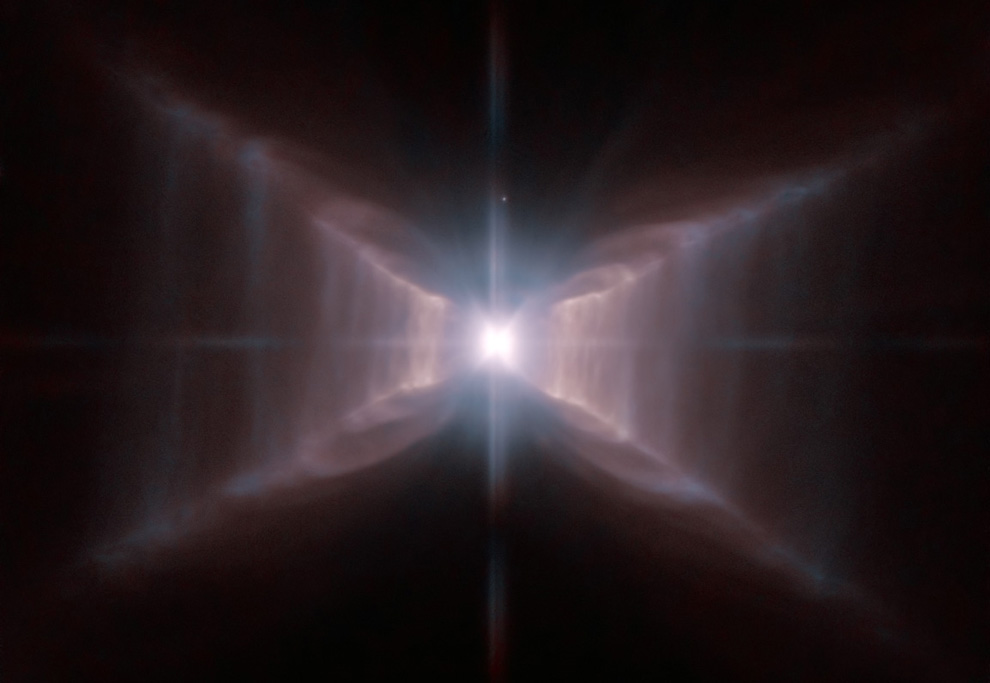
The star HD 44179 is surrounded by an extraordinary structure known as the Red Rectangle. It acquired its moniker because of its shape and its apparent colour when seen in early images from Earth. This strikingly detailed new Hubble image reveals how, when seen from space, the nebula, rather than being rectangular, is shaped like an X with additional complex structures of spaced lines of glowing gas, a little like the rungs of a ladder. The star at the centre is similar to the Sun, but at the end of its lifetime, pumping out gas and other material to make the nebula, and giving it the distinctive shape. It also appears that the star is a close binary that is surrounded by a dense torus of dust - both of which may help to explain the very curious shape. The Red Rectangle is an unusual example of what is known as a proto-planetary nebula. These are old stars, on their way to becoming planetary nebulae. Once the expulsion of mass is complete a very hot white dwarf star will remain and its brilliant ultraviolet radiation will cause the surrounding gas to glow. The Red Rectangle is found about 2,300 light-years away in the constellation Monoceros (the Unicorn). (ESA/Hubble and NASA) More #
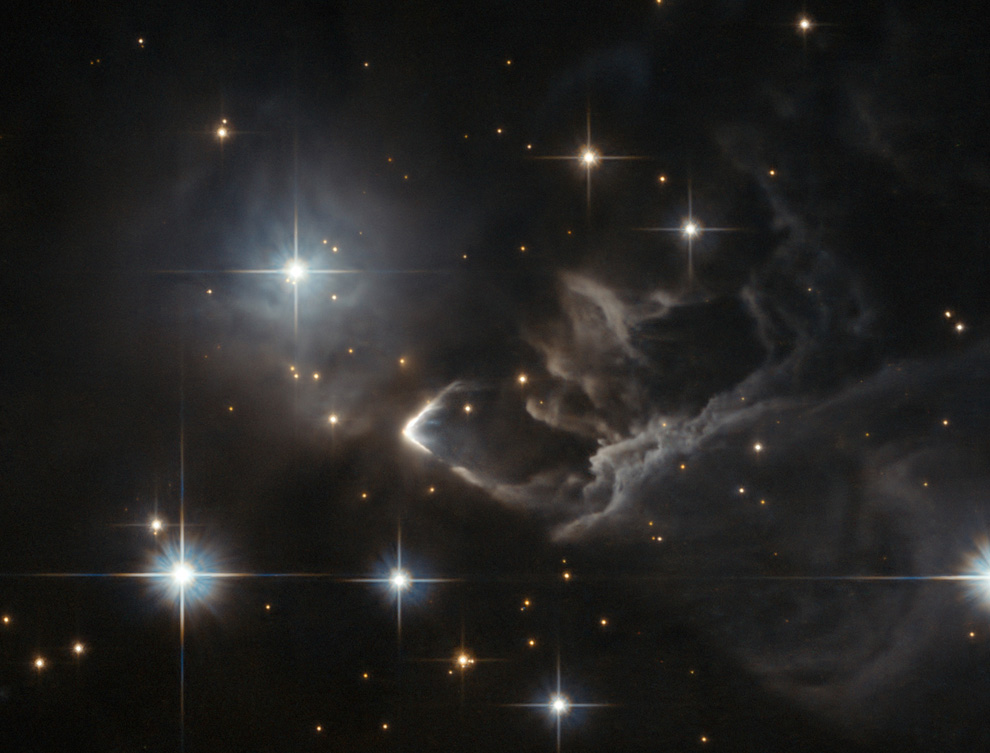
The little-known nebula IRAS 05437+2502 billows out among the bright stars and dark dust clouds that surround it in this striking image from the Hubble Space Telescope. It is located in the constellation of Taurus (the Bull), close to the central plane of our Milky Way galaxy. Unlike many of Hubble's targets, this object has not been studied in detail and its exact nature is unclear. At first glance it appears to be a small, rather isolated, region of star formation and one might assume that the effects of fierce ultraviolet radiation from bright young stars probably were the cause of the eye-catching shapes of the gas. However, the bright boomerang-shaped feature may tell a more dramatic tale. The interaction of a high velocity young star and the cloud of gas and dust may have created this unusually sharp-edged bright arc. Such a reckless star would have been ejected from the distant young cluster where it was born and would travel at 200,000 km/hour or more through the nebula. This faint cloud was originally discovered in 1983 by the Infrared Astronomical Satellite (IRAS), the first space telescope to survey the whole sky in the infrared. (ESA/Hubble, R. Sahai and NASA) More #
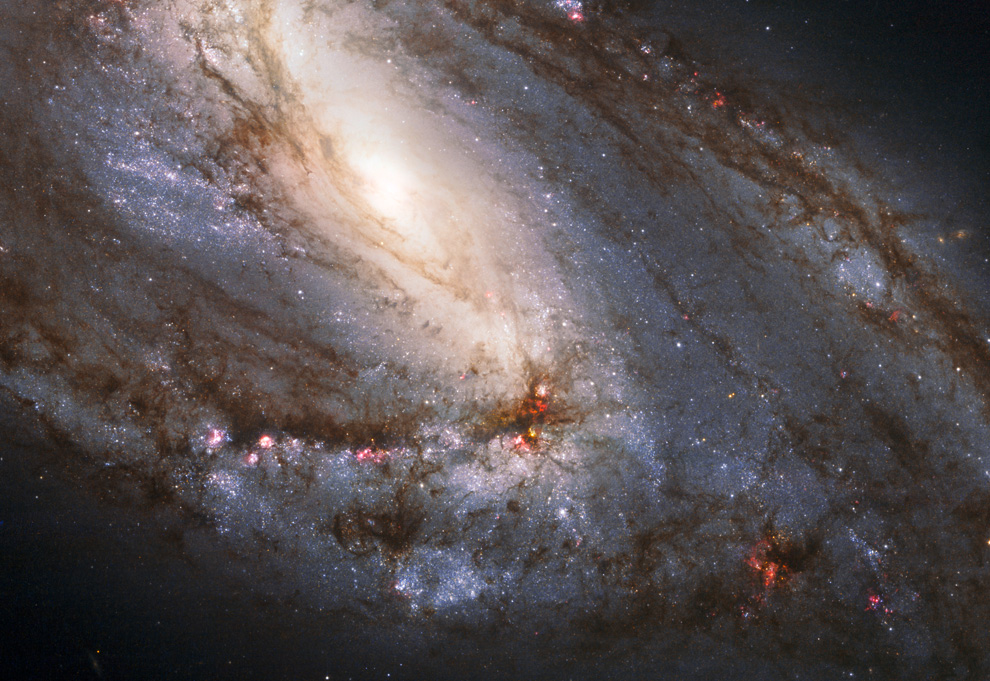
A spectacular view of Messier 66, the largest "player" of the Leo Triplet, a galaxy with an unusual anatomy: it displays asymmetric spiral arms and an apparently displaced core. The peculiar anatomy is most likely caused by the gravitational pull of the other two members of the trio. The unusual spiral galaxy is located at a distance of about 35 million light-years in the constellation of Leo. Together with Messier 65 and NGC 3628, Messier 66 is the member of the Leo Triplet, a trio of interacting spiral galaxies, part of the larger Messier 66 group. Messier 66 wins in size over its fellow triplets - it is about 100,000 light-years across. (NASA, ESA and the Hubble Heritage, STScI/AURA) More #
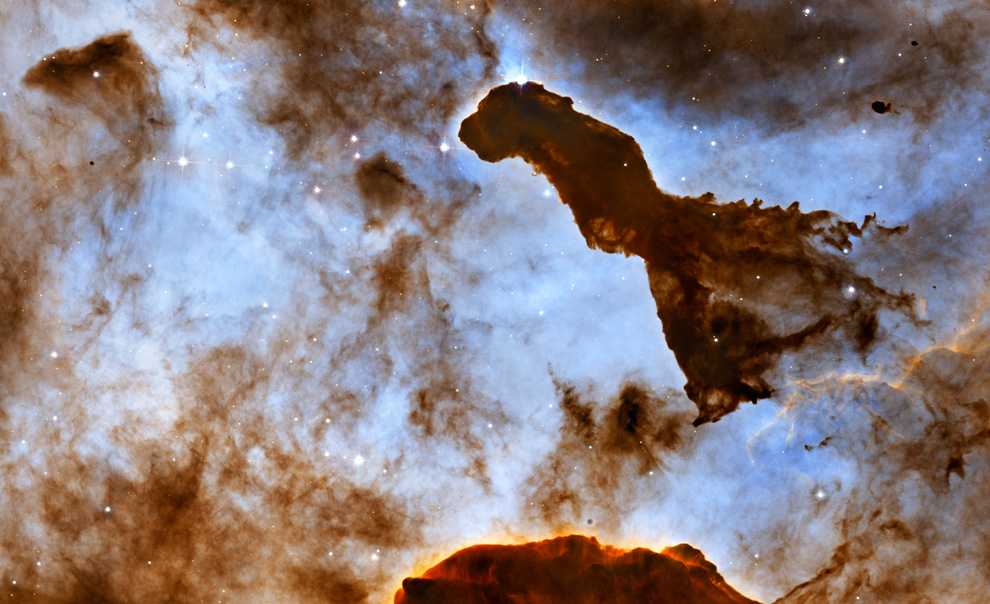
This light-year-tall tendril of cold hydrogen and dust and surrounding dust clouds, imaged by the Hubble Space Telescope, are located in the Carina Nebula. Violent stellar winds and powerful radiation from massive stars are sculpting the surrounding nebula. Inside the dense structures, new stars may be born. This image is a composite of 2005 observations taken of the region in hydrogen light (light emitted by hydrogen atoms) along with 2010 observations taken in oxygen light (light emitted by oxygen atoms), both times with Hubble's Advanced Camera for Surveys. The immense Carina Nebula is an estimated 7,500 light-years away in the southern constellation Carina. (NASA, ESA, and the Hubble Heritage Project, STScI/AURA). More #
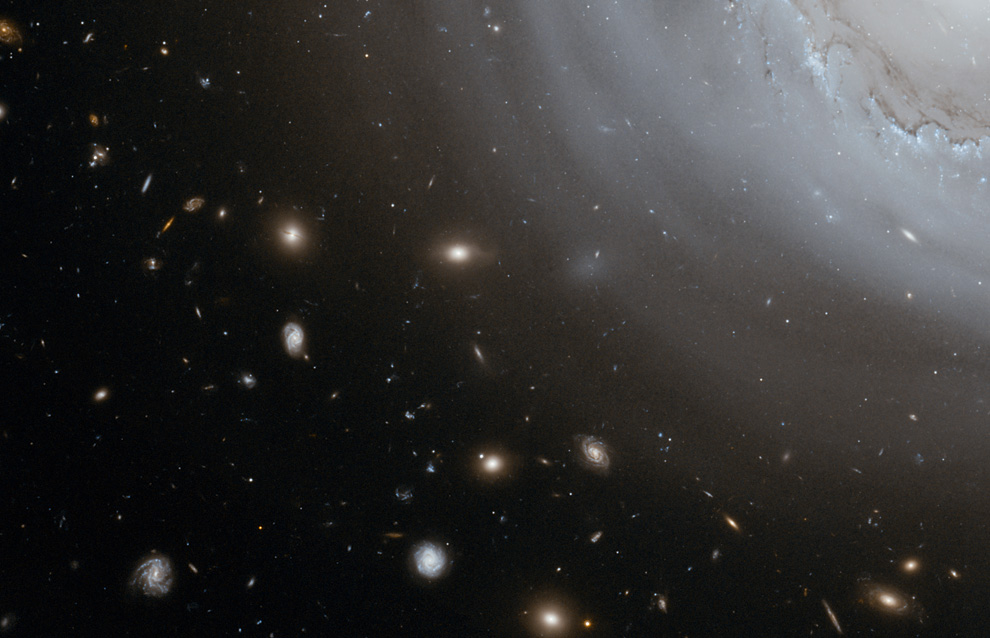
In the upper right of this image is part of NGC 4921, an unusual spiral galaxy in the Coma Galaxy Cluster some 320 million light-years from Earth, with a backdrop rich with a variety of much more distant galaxies. The long exposure times and sharp vision of Hubble allowed it to not just image NGC 4921 in fine detail but also to see far beyond into the distant Universe. All around, and even through the galaxy itself, thousands of much more remote galaxies of all shapes, sizes and colours are visible. Many have the spotty and ragged appearance of galaxies at a time before the familiar division into spirals and ellipticals had become established. This image was created from 50 separate exposures through a yellow filter and another 30 exposures through a near-infrared filter using the Wide Field Channel of the Advanced Camera for Surveys on Hubble. The total exposure times were approximately seventeen hours and ten hours respectively. (NASA, ESA and K. Cook, Lawrence Livermore National Laboratory, USA) More #
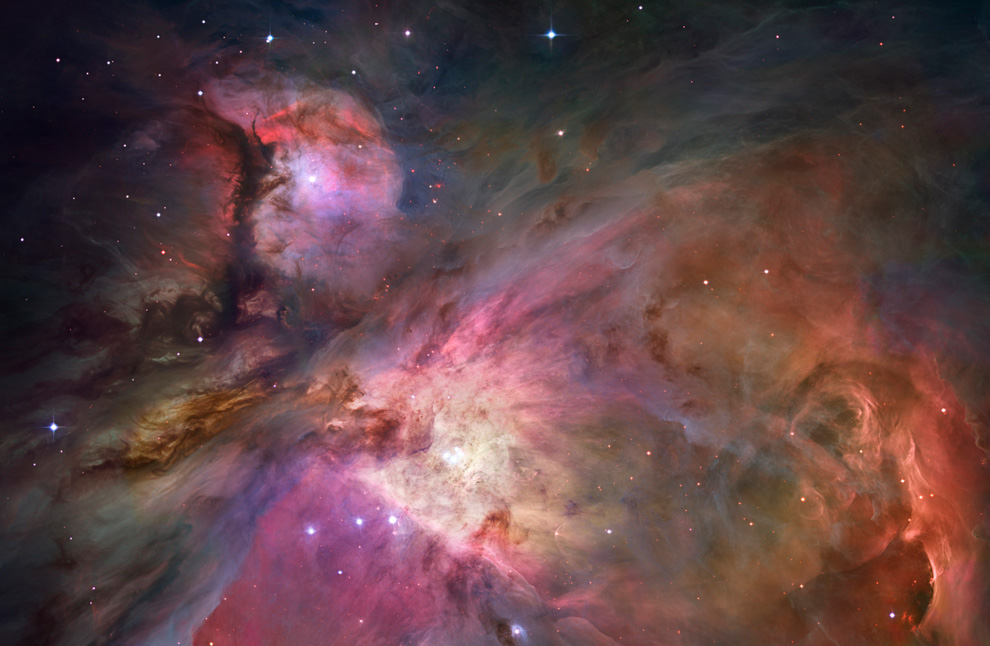
A detail of a larger mosaic - the sharpest view ever taken of the Orion Nebula - a picture book of star formation with massive young stars that are shaping the nebula and pillars of dense gas that may be the homes of budding stars. The bright glow at t is from M43, a small region being shaped by ultraviolet light from a massive young star. Astronomers call the region a miniature Orion Nebula because only one star is sculpting the landscape. The Orion Nebula has four such stars. The Orion Nebula is 1,500 light-years away, the nearest star-forming region to Earth. (NASA, ESA, M. Robberto - STScI) More #
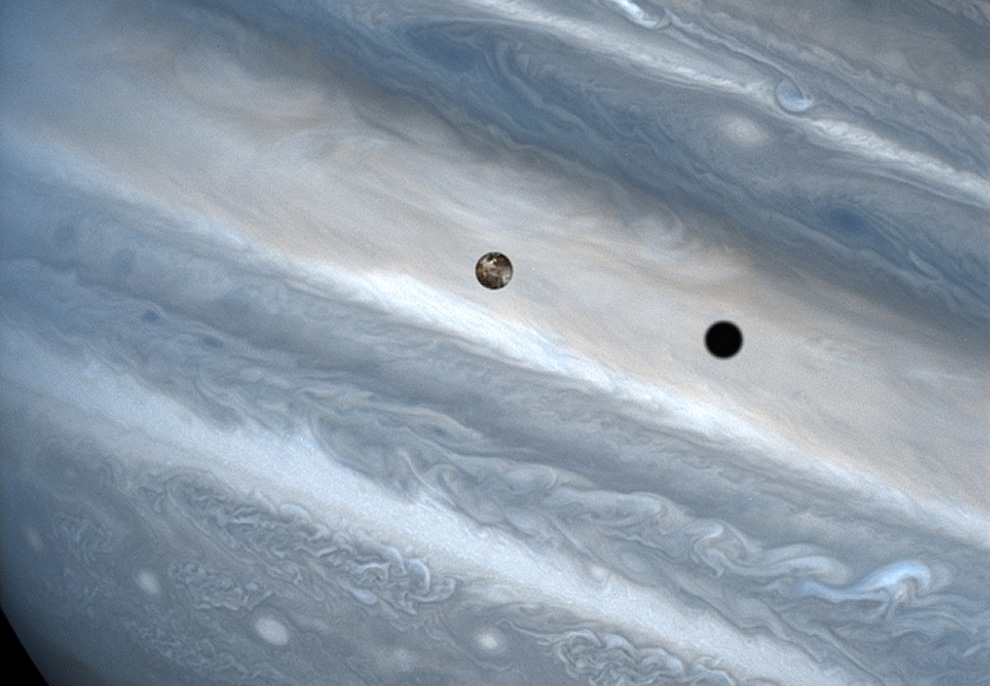
While hunting for volcanic plumes on Io, the Hubble telescope captured these images of the volatile moon sweeping across the giant face of Jupiter in 1999. Io appears to be skimming Jupiter's cloud tops, but it's actually 500,000 km (310,000 mi) away. The conspicuous black spot on Jupiter is Io's shadow and is about the size of the moon itself (3,640 km or 2,262 mi across). This shadow sails across the face of Jupiter at 17 km per second (38,000 mph). The smallest details visible on Io and Jupiter measure 93 miles (150 kilometers) across, or about the size of Connecticut. (J. Spencer, Lowell Observatory and NASA/ESA) More #
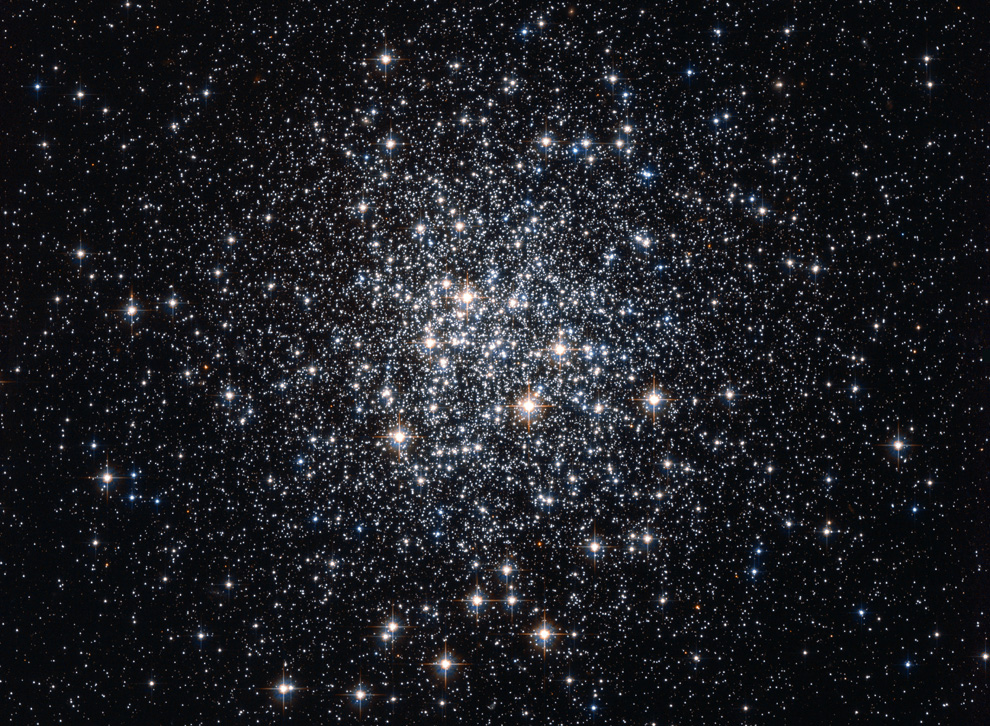
Messier 72 is a globular cluster, an ancient spherical collection of old stars packed much closer together at its center. French astronomer Pierre Mechain discovered this rich cluster in August of 1780, but we take Messier 72's most common name from Mechain's colleague Charles Messier, who recorded it as the 72nd entry in his famous catalogue of comet-like objects just two months later. This globular cluster lies in the constellation of Aquarius (the Water Bearer) about 50,000 light-years from Earth. The total exposure time for this image was about twenty minutes, its field of view about 3.4 arcminutes across. (ESA/Hubble and NASA)More #

This mosaic image of the magnificent starburst galaxy, Messier 82 (M82) is the sharpest wide-angle view ever obtained of M82. It is a galaxy remarkable for its webs of shredded clouds and flame-like plumes of glowing hydrogen blasting out from its central regions where young stars are being born 10 times faster than they are inside in our Milky Way Galaxy. Also known as the Cigar Galaxy, M82 lies over 11 million light years away from Earth. (NASA, ESA and the Hubble Heritage Team STScI/AURA) More #
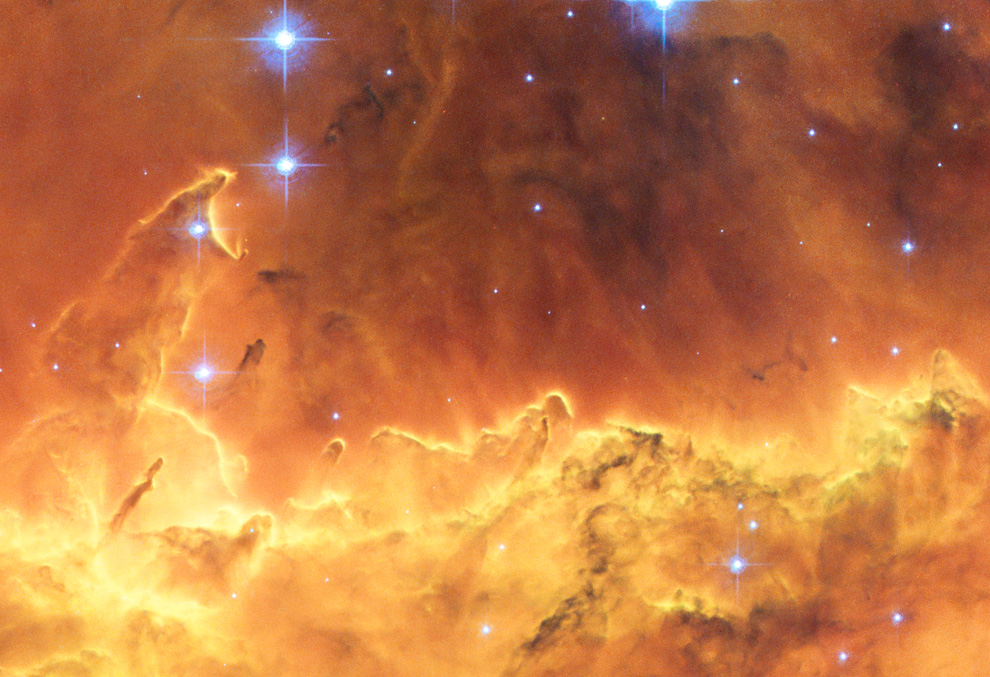
A colourful star-forming region is featured in this image of NGC 2467. Looking like a roiling cauldron of some exotic cosmic brew, huge clouds of gas and dust are sprinkled with bright blue, hot young stars. Strangely shaped dust clouds are silhouetted against a colourful background of glowing gas. Like the familiar Orion Nebula, NGC 2467 is a huge cloud of gas, mostly hydrogen, that serves as an incubator for new stars. Hot young stars that recently formed from the cloud are emitting fierce ultraviolet radiation that is causing the whole scene to glow while also sculpting the environment and gradually eroding the gas clouds. (NASA, ESA and Orsola De Marco, Macquarie University) More #
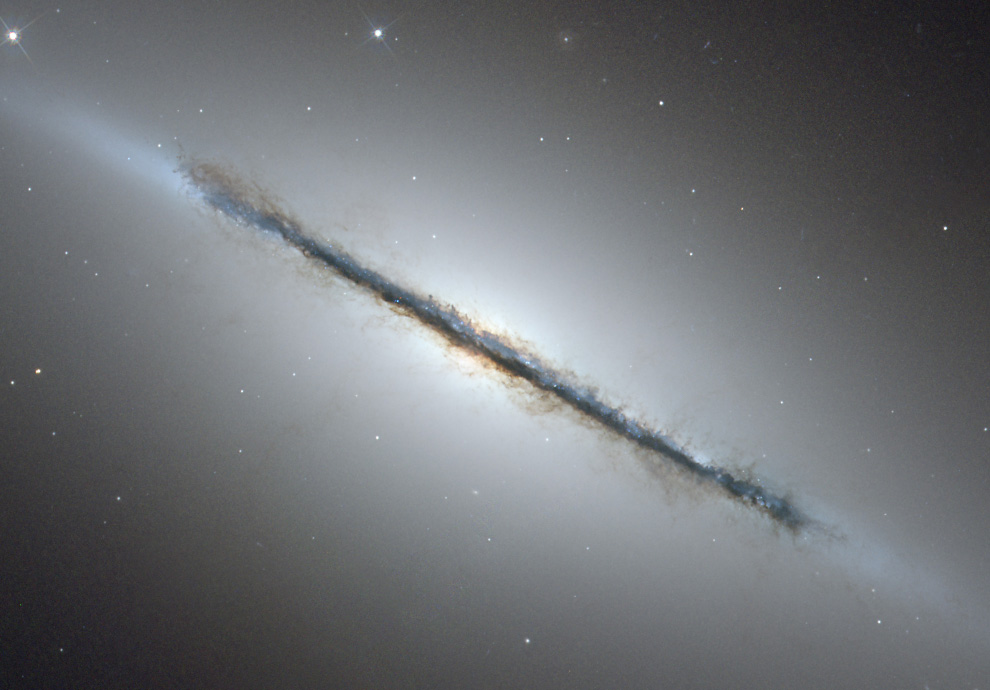
Hubble's sharp vision reveals a crisp dust lane dividing the disk galaxy NGC 5866 into two halves. The image highlights the galaxy's structure: a subtle, reddish bulge surrounding a bright nucleus, a blue disk of stars running parallel to the dust lane, and a transparent outer halo. (NASA, ESA, and The Hubble Heritage Team STScI/AURA) More #

Two galaxies perform an intricate dance in this new Hubble Space Telescope image. The galaxies, containing a vast number of stars, swing past each other in a graceful performance choreographed by gravity. The pair, known collectively as Arp 87, is one of hundreds of interacting and merging galaxies known in our nearby universe. The two main players comprising Arp 87 are NGC 3808 on the right (the larger of the two galaxies) and its companion NGC 3808A on the left. NGC 3808 is a nearly face-on spiral galaxy with a bright ring of star formation and several prominent dust arms. Stars, gas, and dust flow from NGC 3808, forming an enveloping arm around its companion. NGC 3808A is a spiral galaxy seen edge-on and is surrounded by a rotating ring that contains stars and interstellar gas clouds. The ring is situated perpendicular to the plane of the host galaxy disk and is called a "polar ring." As seen in other mergers similar to Arp 87, the corkscrew shape of the tidal material or bridge of shared matter between the two galaxies suggests that some stars and gas drawn from the larger galaxy have been caught in the gravitational pull of the smaller one. The shapes of both galaxies have been distorted by their gravitational interaction with one another. Arp 87 is in the constellation Leo, approximately 300 million light-years away from Earth. (NASA, ESA, and the Hubble Heritage Team, STScI/AURA) More #
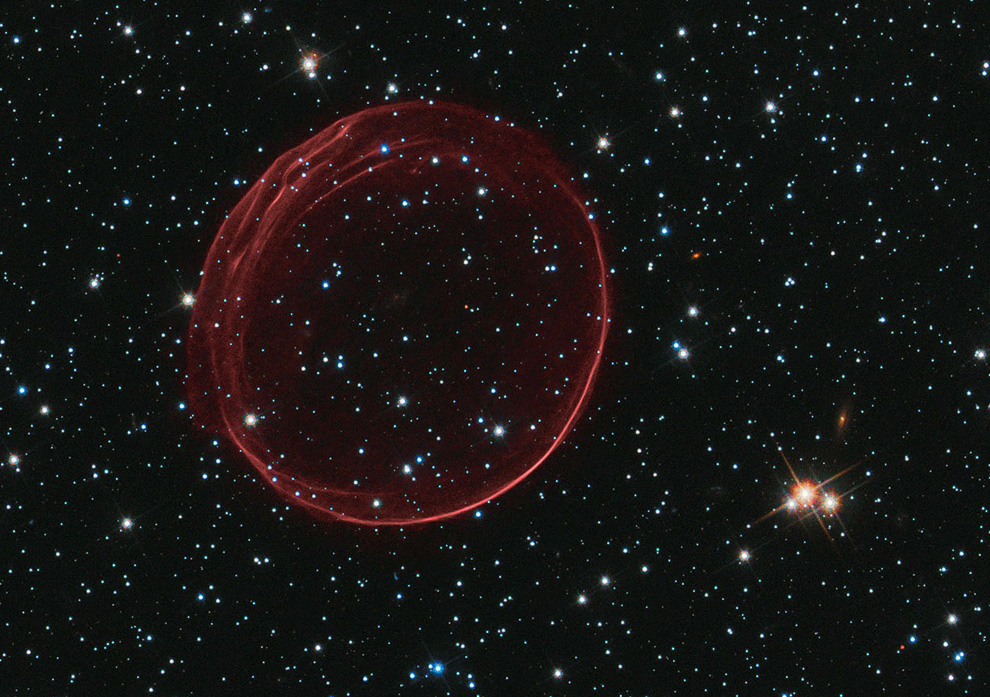
A delicate sphere of gas, photographed by NASA's Hubble Space Telescope, floats serenely in the depths of space. The pristine shell, or bubble, is the result of gas that is being shocked by the expanding blast wave from a supernova. Called SNR 0509-67.5 (or SNR 0509 for short), the bubble is the visible remnant of a powerful stellar explosion in the Large Magellanic Cloud (LMC), a small galaxy about 160,000 light-years from Earth. Ripples in the shell's surface may be caused by either subtle variations in the density of the ambient interstellar gas, or possibly driven from the interior by pieces of the ejecta. The bubble-shaped shroud of gas is 23 light-years across and is expanding at more than 11 million miles per hour (5,000 kilometers per second). (NASA, ESA, and the Hubble Heritage Team, STScI/AURA)More #
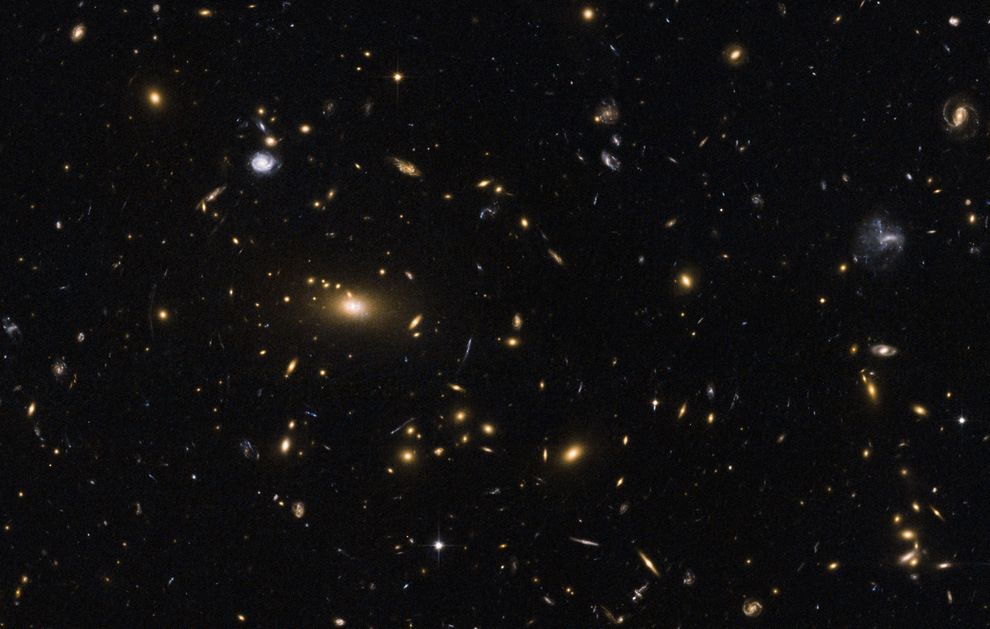
Small, dim galaxies appear to flit like moths around a radiant street light in this image. The brilliant central object is a supergiant elliptical galaxy, the dominant member of a galaxy cluster with the mouthful of a name MACSJ1423.8+2404. This great swarm of galaxies is located about five billion light-years away in the constellation Boötes (the Herdsman). The gentle arcs surrounding the central galaxy are distorted views of even more distant galaxies. The gravity of the closer large galaxy creates a gravitational lensing effect, distorting and amplifying the light that passes close by on its way to an observer, like us. (ESA/Hubble and NASA) More #

In one of the largest and most detailed celestial images ever made, the coil-shaped Helix Nebula shows a fine web of filamentary "bicycle-spoke" features embedded in a colorful red and blue gas ring comprising one of the nearest planetary nebulae to Earth. Because the nebula is nearby, it appears as nearly one-half the diameter of the full Moon. The portrait offers a dizzying look down what is actually a trillion-mile-long tunnel of glowing gases. The fluorescing tube is pointed nearly directly at Earth, so it looks more like a bubble than a cylinder. A forest of thousands of comet-like filaments, embedded along the inner rim of the nebula, points back toward the central star, which is a small, super-hot white dwarf. (NASA, NOAO, ESA, the Hubble Helix Nebula Team, M. Meixner, STScI, and T.A. Rector, NRAO)More #
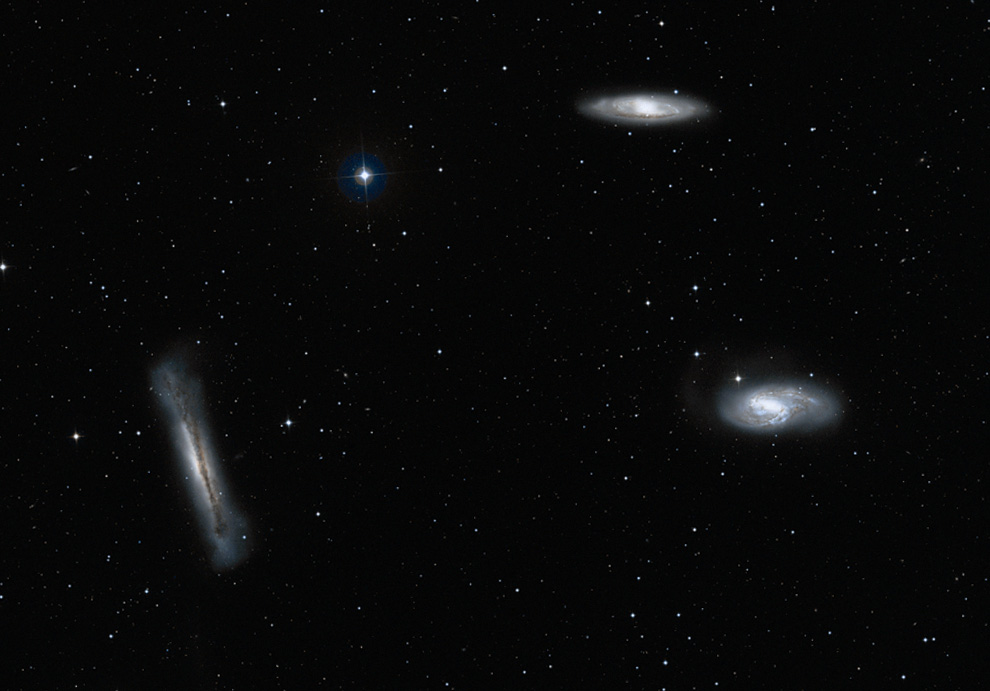
Remember the earlier image of galaxy M66, a part of the Leo Triplet? This is a wider view, showing all three members of the triplet, M66 is lower right, M65 is at top right and galaxy NGC 3628 is seen nearly edge-on at left. The trio of spiral galaxies lies about about 35 million light-years away from Earth. (NASA, ESA and and Digitized Sky Survey 2 Davide De Martin, ESA/Hubble) More #
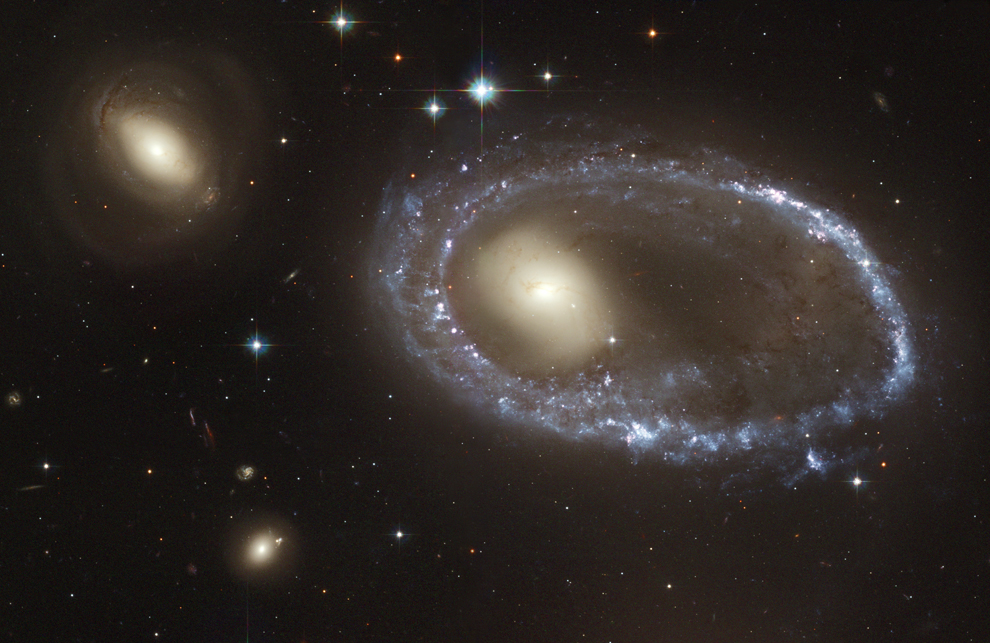
A ring of brilliant blue star clusters wraps around the yellowish nucleus of what was once a normal spiral galaxy in this new image from the NASA/ESA Hubble Space Telescope. The ring is 150,000 light-years in diameter, making it larger than our entire home galaxy, the Milky Way. The galaxy, cataloged as AM 0644-741, is a member of the class of so-called "ring galaxies." It lies 300 million light-years away in the direction of the southern constellation Dorado. (NASA, ESA, and The Hubble Heritage Team, AURA/STScI) More #
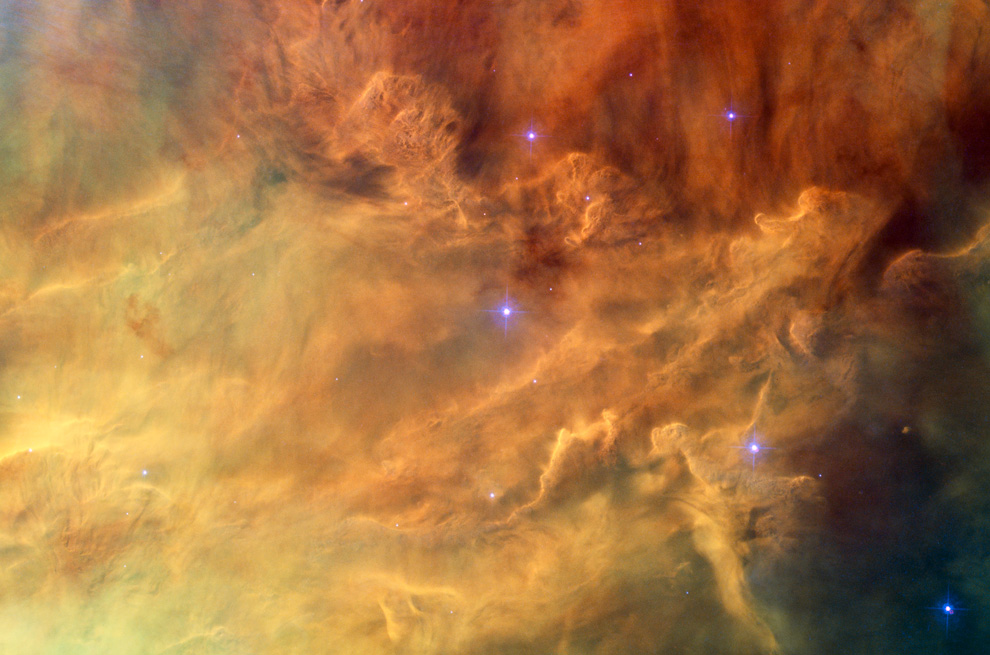
This close-up shot of the center of the Lagoon Nebula (M8) clearly shows the delicate structures formed when the powerful radiation of young stars interacts with the hydrogen cloud they formed from. The Lagoon Nebula lies some 4,100 light years away. This image was created from exposures taken with the Wide Field Channel of the Advanced Camera for Surveys on Hubble. Light from glowing hydrogen is colored red, light from ionised nitrogen is colored green and light through a yellow filter is colored blue. (NASA, ESA) More #
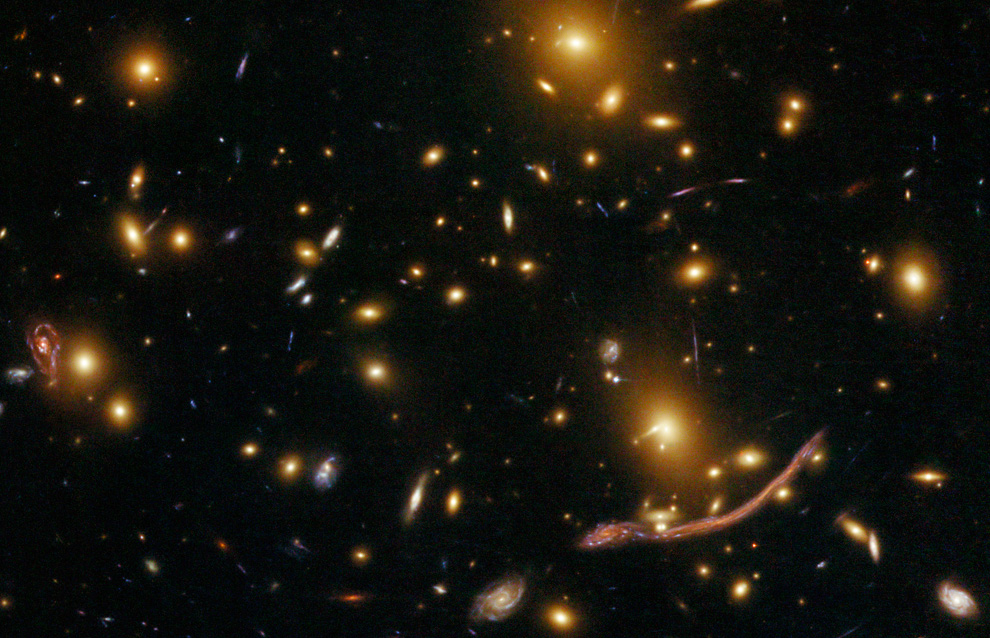
Abell 370 is one of the very first galaxy clusters where astronomers observed the phenomenon of gravitational lensing, the warping of space-time by the cluster's gravitational field that distorts the light from galaxies lying far behind it. This is manifested as arcs and streaks in the picture, which are the stretched images of background galaxies. Ground-based telescopic observations in the mid-1980s of the most prominent arc nicknamed "the Dragon" (lower right) allowed astronomers to deduce that the arc was not a structure of some kind within the cluster, but the gravitationally lensed image of a galaxy that lies nearly 10 billion light years away. Hubble has now resolved new, previously unseen details in the arc that reveal structure in the lensed background galaxy. (NASA, ESA, the Hubble SM4 ERO Team and ST-ECF) More #
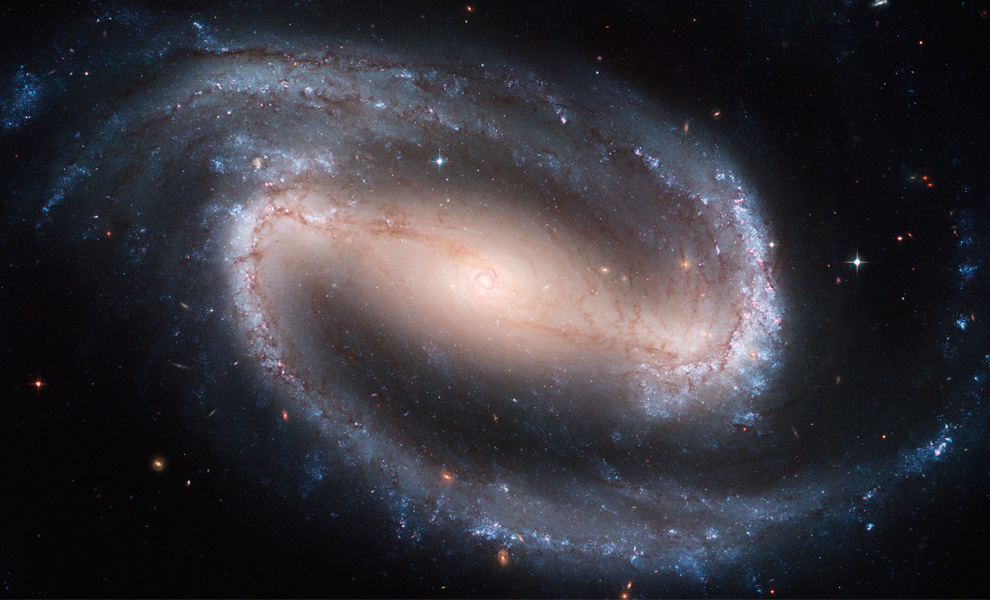
Barred spiral galaxy NGC 1300 is considered to be prototypical of barred spiral galaxies. Barred spirals differ from normal spiral galaxies in that the arms of the galaxy do not spiral all the way into the center, but are connected to the two ends of a straight bar of stars containing the nucleus at its center. At Hubble's resolution, a myriad of fine details are seen throughout the galaxy's arms, disk, bulge, and nucleus. Blue and red supergiant stars, star clusters, and star-forming regions are well resolved across the spiral arms, and dust lanes trace out fine structures in the disk and bar. Numerous more distant galaxies are visible in the background. In the core of the larger spiral, the nucleus shows its own extraordinary and distinct "grand-design" spiral structure that is about 3,300 light-years long. NGC 1300 lies roughly 69 million light-years away in the direction of the constellation Eridanus. (NASA, ESA, and The Hubble Heritage Team, STScI/AURA) More #
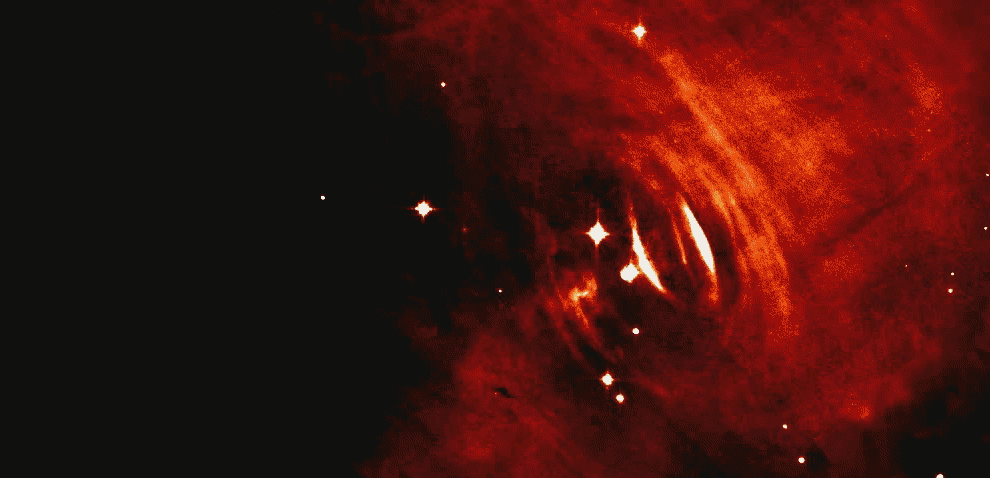
Look carefully at this animated image. What you see is the Crab pulsar, a rapidly rotating neutron star at the heart of the Crab Nebula, propelling matter and antimatter outward at near the speed of light, seen in 24 sequential images acquired over several months by the Hubble Space Telescope. The Crab pulsar is a tiny, dense remnant of a star that exploded in a supernova, observed here on Earth in the year 1054. It is very small - only about 25 km (15 miles) across, has a mass about 1.5 times our own Sun, and rotates at an amazing rate of 30 times per second. Bright wisps of energetic particles can be seen moving outward from the pulsar at half the speed of light to form an expanding ring. These wisps appear to originate from a shock wave that shows up as an inner X-ray ring. Also, a turbulent jet appears to be spewing material to the left, looking much like steam from a high-pressure boiler - except it's a stream of matter and anti-matter electrons moving at half the speed of light. This little neutron star, some 6,500 light-years away, has been doing this energetic pirouette for the past thousand years, and, undisturbed, will likely continue to do so for billions of years more. One thing I always want to take away from time spent looking at Hubble images: the Universe is a very dynamic place, even if it can often appear static due to vast distances and scales. (NASA/HST/ASU/J. Hester) More -- I hope you've enjoyed this year's Hubble Advent calendar as much as I enjoyed putting it together. Merry Christmas, Happy New Year, and wishes for peace on Earth and goodwill toward men. -Alan #